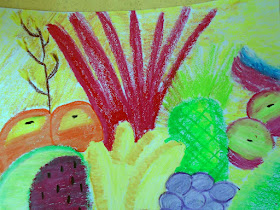NATURE AND PEACE
Bantaoay Children’s Integrated Art Workshop
San Vicente, Ilocos Sur, May 16 to 18, 2018
Selected Works
Dr Abe V Rotor
Workshop Instructor
Birds flying low over the field and tall grass
meet the morning sun, but never in a rush.
Neil, 8
Flying kite is a wholesome pastime for kids,
away from computers, loafing and misdeeds.

Shaun Michael R Remular, 11
Fluffy clouds hang free above the trees,
while the wind blows gentle into breeze.

Migi, 7
A hut among the trees, my home,
I shall never want and feel alone.
Jamiela Marie Almachar, 8
A world of a kind: three trees, three birds, three kids,
from the bigger world, peace and freedom never at siege.
Fantasy land, romanticism its uniqueness;
somewhere carved out of our loneliness.
Tristan, 11
Blue pond, reflection of a clear sky and peace around,
wonder where these three passersby are bound.
Field scorched in hot dry summer,
takes a break with the first shower.

Jeod, 11
Rebirth comes in many ways, yet all the same;
life coming back is our Creator’s lovely game.
Vitrish Anne Arguelles, 6
Like a jIgsaw puzzle, the cracks of the soil mend with rain,
save the wastelands, often cursed, yet life’s last domain.
Sandra Valencia, 10
Life peeping through, shy and afraid;
says the sun, “Get up and be brave.”
Christian Delle Garcia, 12
After the first rain in May,
creep the lowly algae;
living things soon aplenty
arrive here and stay.
Jedd, 11
Ahoy, there! Keep off the rocky shore!
Join the race in the deep blue azure.

Jamie Althen Florendo, 12
Dark clouds at sunset tell of a coming storm.
Hurry up for home before high waves form.

The sun is biggest on the western horizon,
smallest on the east just when it is born.
Jamiela Marie Almachar, 6
Savage fangs spare no one at sea,
even the bold ones crying for plea.
Tristan, 11
Join the regatta and vie for the trophy;
romantic, but the danger is another story.

Shaun Michael Remular
Sea gypsies for want of settling down,
travel on boats to nowhere bound.
Denise Kaye R Ancheta
Wind blowing hard like giant arms at sea,
warns of misery and death without mercy.
Christian Delle Garcia, 13
If all fruits were yellow, orange, and red,
I would pick the green for ripening;
If all fruits come in the summer season
I would sorely miss those in spring.
Franceska Billedo, 10
Coy and shy fuits may appear to some one,
wait until they are ripened by the sun.

Frea Billedo, 12
A basket full of fruits and flowers,
the best the fairest maid showers.

Jamie Althea Florendo, 12
Fruits are full of energy,
stored by the sun and Thee.
Jamiela Marie Almachar, 8
All fruits a work of the bee,
if we review our ecology.
Wacky B, 10
Move over fancy culinary;
give way to Ceres’ bounty.

Lance Adam, 5
Where goddess Ceres descends,
Epicurus joins the feast,
and man contends -
else the banquet be missed. ~































































